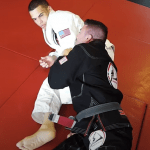Defending an armbar is a crucial skill we BJJ practitioners need to learn or know what makes it so effective as a submission tool. The armbar from mount is a difficult place to be when defending the submission. Usually, your opponent is in full mount and then transition to S mount to armbar; that is where we’ll start the escape.
Armbar: A joint lock where the elbow is hyperextended in order to cause pain and/or injury.
When you are defending the armbar from the mount position, you’ll need to calm and trust the technique, things can happen very fast, and you can get submitted. Things to keep in mind when you are defending the armbar:
- Hold your exposed arm by griping your hands; ball and socket grip, gable grip, S grip, or the RNC type of grip; you can always grab the fabric of your Gi jacket. This is a crucial time to buy out time before the escape.
- Be aware of your opponent’s position; does your opponent have a secure armbar? Is he/she is bitting with the heels against you? is your opponent crossed his feet or not? Your opponent’s chest is close to your trapped arm? All these questions are important to escape; sometimes, you see an opening for an escape. That being said, there are several ways to escape.
- Whatever escape you will choose, you’ll need to keep in mind that if your thumb from the trapped arm is pointing to the sky, you are prone to the armbar; you’ll need to do thumb-up pointing to the matt. When your thumb is pointing to the mat and your elbow away from the center of your opponent’s body, you can prevent the fulcrum point from serving for the arm’s hyperextension. This way, where you can safely bend it the natural way, preventing the submission.
- Be patient, but do not linger too much without planning your next move.
Several escapes are depending on the situation; we will discuss one from Maxum Brazilian Jiu-Jitsu.
- Secure your position hiding your trapped arm; this will allow you some time for the next move.
- Next, you need to go from perpendicular to parallel to your opponent’s position, lift your legs opposite to your opponent then bridge to break his ‘biting’ heels. You can then move both hands below your opponent’s leg, the one closest to your head. You are getting closer to a parallel position. Even if your opponent goes for the kill, you can swing back against his body with your thumb down defense to prevent the submission. Then you can walk your body to a parallel position, braking his posture and making it very hard to pull the submission. Then you can walk towards your opponent, pulling your trapped arm free. You more likely end up on a scramble, where you can gain several positions like side control.
Let’s explore the escape from the following video

















Comments 0